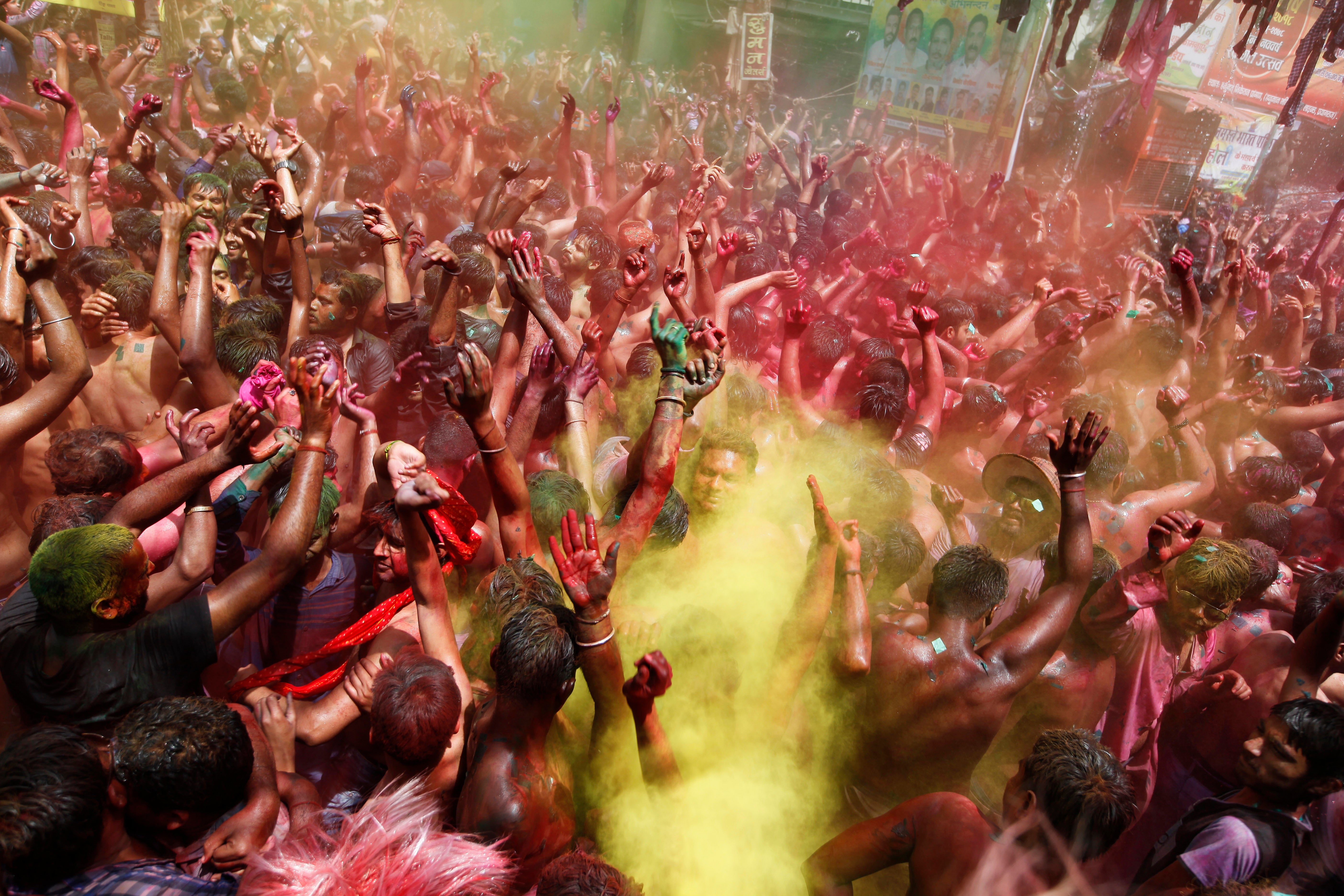Huge crowds seen at Holi despite Covid concerns as expert says country ‘is in second wave’
Infections rising at double pace as situation turns from ‘bad to worse’

India witnessed large-scale violations of Covid-19 rules at the weekend as significant numbers of people gathered to celebrate one of the biggest Hindu festivals, Holi, despite alarm over a resurgence of coronavirus – as the country added the fastest 100,000 cases ever in just four days.
Experts said the second-most populous country is under a second wave of the pandemic and the rate at which infections are rising is “worrisome”.
India recorded a new wave of infections for the 20th day in a row, with cases passing the 12 million mark, after a hiatus lasting months.
As health authorities scrambled to curb a resurgence of virus and about 550,000 people battled the infectious disease, a huge number of maskless people gathered in a number of Indian cities to celebrate the festival of colours on 28 and 29 March.
Speaking to The Independent, Dr Shahid Jameel, the country’s leading virologist, said India was in the middle of a second wave and the pandemic was now creeping to places and people which were spared during the first wave.
Read more:
- China warns US over ‘red line’ after American ambassador makes first Taiwan visit for 42 years
- Beijing sandstorm makes sun appear blue and sky yellow
- Military ‘opens fire on mourners’ at funeral for Myanmar protester killed in deadly crackdown
- Why well-heeled travellers are flocking to Kenya during lockdown
“If you see the trajectory of the infections, it took 66 days to move from 10 million to 11 million cases and to reach 11 million to 12 million we have taken only 34 days. The rate at which the infection is rising is worrisome,” Dr Jameel said.
A senior health official in their latest briefing said India’s Covid situation was spiralling from “bad to worse” and will eventually end up “overwhelming the system”, reported Reuters.
Dr VK Paul, a senior official in the health ministry, criticised states like Punjab for inadequate testing.
People breached restrictions put in place for Holi in many cities, including Vrindhavan, Guwahati, Mumbai and Gorakhpur. Dr Jameel said the fallout of celebrations would only be witnessed in the coming weeks.
According to health ministry data, India logged a total of 68,020 new infections on Monday, the same day as people celebrated Holi.
The mortality rate has not increased, however experts said it was too early to reach conclusions as deaths tend to show in statistics around two weeks after infection.
On Tuesday, the new-daily infections came down to 56,211, but testing also dropped due to the national holiday.
The sudden surge in cases has reportedly led to a shortage of ICU beds in private hospitals in Pune, Mumbai and Delhi.
India has seen the sharpest spike since the beginning of the pandemic last March in terms of the absolute number of new cases, with 200,0000 cases recorded in the last week.
Dr Jameel said there were many driving factors for the surge. A large population of susceptible people, complacency when it comes to coronavirus rules and mutant variants are all pushing India towards the surge.
Dr Jameel said that while the increase in cases is yet to be epidemiologically linked to mutant variants, that was likely to emerge as the cause.
“Some of these variants are more infectious. The sequencing of the virus from Punjab, one of the states showing an uptick in cases, shows almost 80 per cent of people with the UK variant. With that sort of circulation, in community surge is expected,” he said.
Last week, in a major setback to India’s Covid efforts, a new “double mutant” variant of the coronavirus was detected from some of the samples collected.
The double mutant means two individual mutations in a particular virus: one causes increased infection (patient will have increased multiplication and increased transmission) and the second mutation showed some evasion of preexisting immunity, explained Dr Jameel.
The double mutant is responsible for about 20 per cent of cases from Maharashtra and Telangana.
India’s second wave seems to be more powerful than the first one, when the country saw single-day surges of almost 100,000 cases. However, it has recorded 100,000 cases in a shorter amount of time in 2021 compared to the first wave last year.
India added 300,000 cases in just 17 days in the second wave, while it logged the same number of infections over a 26 day period in 2020.
Infections have been rising at a double pace in the second wave, according to the Times of India dashboard.
Maharashtra, home to Mumbai, the country’s financial hub has been the worst-hit state with about 70 per cent of the total infections.
“Trends show the virus is still very active. Just when we think we can control it, it sparks back,” Dr Paul, chairman of the National Expert Committee on Vaccine Administration, said on Tuesday. “Remember if the cases are more, they will eventually overwhelm the system.”
According to the health ministry’s Monday’s briefing, 10 states are showing a rise in Covid infections, including Maharashtra, Gujarat, Punjab, Madhya Pradesh, Delhi, Tamil Nadu, Chhattisgarh, Karnataka, Haryana and Rajasthan.
Out of these 10, the five worst-hit states account for 80.17 per cent of the total active cases in the country.
From almost returning in normalcy when the infections were lowest at the start of the year, several states have renewed lockdowns restrictions with Maharashtra mulling going into a state-wide lockdown.
According to the latest orders, the vaccination drive in India would be expanded to all people above 45 years of age from 1 April.
Subscribe to Independent Premium to bookmark this article
Want to bookmark your favourite articles and stories to read or reference later? Start your Independent Premium subscription today.

Join our commenting forum
Join thought-provoking conversations, follow other Independent readers and see their replies